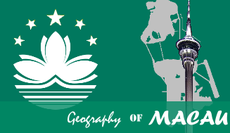
Back Geografía de Macao Spanish Géographie de Macao French 마카오의 지리 Korean Geografi Macau Malay Geografia Makau Polish Geografia de Macau Portuguese 澳門地理 Chinese
 |
| Geography of Macau |
|---|
| Other Macau topics |
| Macau Portal |
Macau is a Special Administrative Region on the southern coast of China. It is located at the south of Guangdong Province, on the tip of the peninsula formed by the Zhujiang (Pearl River) estuary on the east and the Xijiang (West River) on the west. Macau is situated 60 km (37 mi) west of Hong Kong, and 145 km (90 mi) southwest of Guangzhou, the capital of Guangdong Province. It is situated immediately east and south of Zhuhai.
The region comprises the Macau Peninsula and the islands of Taipa and Coloane. Macau was once an island but gradually a connecting sandbar turned into a narrow isthmus. Land reclamation in the 17th century made Macau into a peninsula, and a barrier gate was built to mark the separation between the peninsula and the mainland. Pre-colonial records show that Macau totalled only 2.78 km2 (1.07 sq mi) but began to increase as a result of Portuguese settlement. Land growth has accelerated since the last quarter of the 20th century, from 15 km2 (5.8 sq mi) in 1972 to 16.1 km2 (6.22 sq mi) in 1983 to 21.3 km2 (8.22 sq mi) in 1994. Macau's size has gradually increased as result of continued land reclamation, especially on Taipa and Coloane. In 2014, the total land area was approximately 30.3 km2 (11.7 sq mi).
There is a 0.34 km (0.21 mi) long border between Macau and mainland China and a forty-kilometre-long coastline. The main border crossing between Macau and China is the Portas do Cerco (Barrier Gate) Frontier Checkpoint on the Macau side, and the Gongbei checkpoint on the Chinese side.